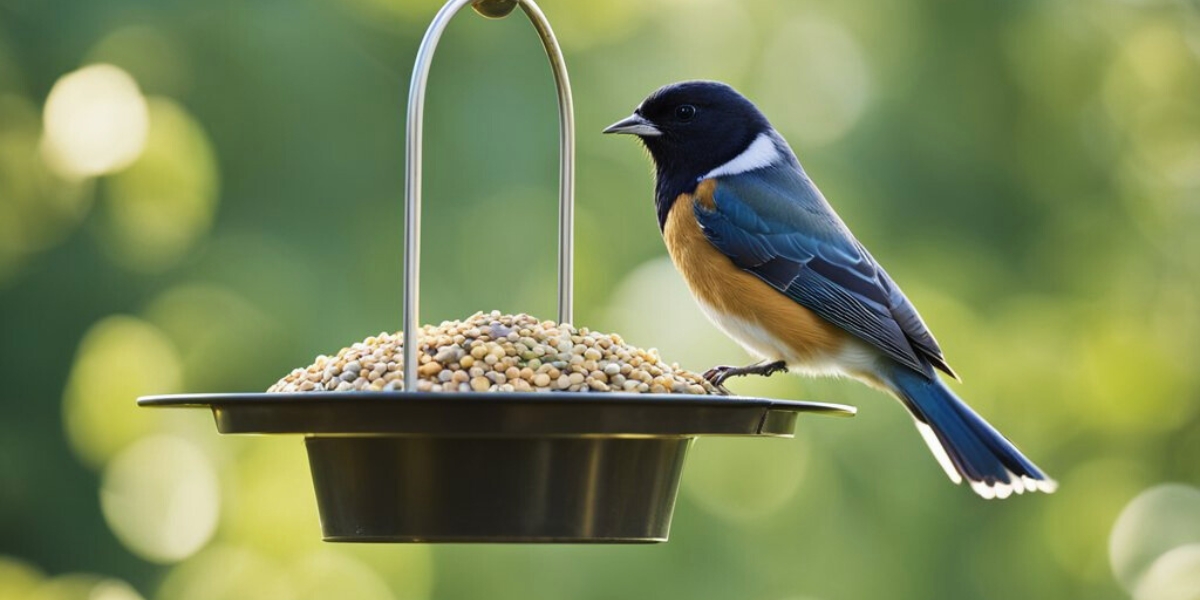Bird lovers often notice piles of discarded seed, shells, and hulls scattered on the ground under their feeders. This waste may seem mysterious, but it is often the result of natural bird behaviors around feeding. There are some key reasons why do birds throw seed out of feeder?
Why Birds Throw Seeds Out of Feeders?
Birds exhibit specialized behaviors around feeders that sometimes result in them actively tossing seeds and food debris onto the ground. Here are 10 explanations for this common phenomenon:
1. Caching Food for Later
Birds instinctively cache or hide food to store up reserves for periods of hardship when fresh food is scarce. Scattering seeds from feeders activates this natural hoarding impulse in birds. They will hurriedly grab mouthfuls of seed from feeders and bury them in caches scattered around the feeder area for future retrieval.
Chickadees, juncos, nuthatches, and blue jays are bird species that frequently exhibit this caching behavior. They swarm feeders and rapidly disperse seeds into hundreds of hidden stashes. Chickadees alone can make over 500 food caches per day! This intense caching provides backup food stores that may make the difference between life and death during the lean winter months.
2. Removing Unwanted Foods and Shells
Birds are selective and discerning eaters. Many will actively toss out cheaper filler seeds or empty shells from favored seeds that end up mixed into feeder blends. This allows them to selectively sort and access only the preferred foods they want to eat from mixed commercial seed mixes.
Sparrows, finches, cardinals, and other species are very picky and will send undesirables quickly tumbling to the ground. Cardinals and grosbeaks are especially prone to cracking open sunflower or safflower shells to get at the inner seed, raining debris below. Removing shells beforehand improves digestion efficiency.
3. Protecting Against Rancid Food
Alert wild birds are adept at visually identifying and removing moldy, rotten, or otherwise contaminated seeds and fruit from feeders. This intentional cleansing-tossing behavior helps protect other members of their flocks from accidentally consuming toxic food and becoming ill.
Social species like finches have evolved strong aversions to eating food that has made them sick in the past. By purposefully throwing out visibly rotten or suspect seeds, they help safeguard the overall health of their fellow flock members.
4. Creating Spacing at Crowded Feeders
When competition at feeders gets too intense during peak activity periods, some clever birds have figured out an advantage to grabbing excess food in their beak and flying a short distance away to eat it in peace.
This intentional scattering of seeds reduces squabbles over prime real estate spots on crowded main feeders. It also provides reliable supplementary ground feeding spots with quick access and less confrontation over ownership. Birds strategically spread resources out to diffuse tensions.
5. Marking Territory
Dominant territorial backyard birds like blue jays may sometimes purposefully scatter seeds from feeders down onto the ground to visibly signal ownership and control over that particular feeding area. These messy caches of debris below feeders effectively mark boundaries for competitors, signaling that this area is claimed and controlled.
A study on blue jays showed that messy seed caches function as social signals to other birds. The jays were essentially communicating, “This is my turf!” Scattering seeds demonstrates power while dissuading intruders.
6. Establishing Social Order
In mixed flocks around backyard feeders, intentionally scattering small amounts of seeds from feeders allows the creation of distinct foraging zones for each group. This clever dispersal reduces conflict and establishes reliable feeding areas for birds of different social statuses.
Dominant groups signal prime real estate spots, while subordinate individuals and juveniles stick to the safer, scattered seeds below. The rules of the social hierarchy are reinforced by how birds spread out food sources.
7. Playing and Amusement
Intelligent social backyard birds like blue jays, crows, magpies, and parrots also sometimes scatter and toss seeds strictly for entertainment purposes. Playfully manipulating food items provides engaging cognitive stimulation and challenges their problem-solving abilities.
Research on ravens and jays reveals they will joyfully play with objects like seeds simply for the rewarding amusement and fun it provides. A feeding game with tasty rewards taps into their innate drives.
8. Practicing Natural Foraging
Another explanation for tossing seeds into leaf litter or grassy yards is that it provides opportunities for young birds to practice natural ground foraging and food manipulation skills through mimicry. The flicking actions of scratching aside debris feel satisfying while honing abilities.
It also allows adult birds opportunities to indulge their primal scavenging instincts and behaviors. Scattering seeds can satisfy evolved foraging drives and preferences.
9. Accessing Feeder Perches
At overcrowded feeders dominated by larger aggressive species, smaller opportunistic birds like chickadees and goldfinches may grab mouthfuls of seed and flutter a short distance away just to eat in peace. This allows them a chance to access feeder perches while also reducing direct conflicts.
By strategically making room, they open up prime real estate spots for others in the pecking order. This seed scattering ultimately increases total feeding opportunities.
10. Clearing Feeder Ports
Impatient birds jostling for position directly on feeder perches will sometimes aggressively rake aside seeds from the ports and push them off onto the ground below. This clearing behavior allows instant access to fresh, preferred seeds and nuts within the feeder body the moment they become available.
Dominant birds ensure a continual buffet by displacing old hulls for new items they favor most. They prioritize eating over nestling behaviors.
People Also Read:
Conclusion
While we may see spilled seed and shells as messy waste, these debris piles actually result from a diverse range of natural behaviors and adaptations in birds. Next time you witness epic feeding frenzies and subsequent ground messes under your yard feeders, take a moment to appreciate the complex bird cognition, communication, and survival strategies on display.
Their motivations provide insight into the remarkable intelligence, resourcefulness, and social structures of our feathered visitors. Rather than getting frustrated, be amazed by bird ingenuity! Offer them an abundant buffet and enjoy the show.

